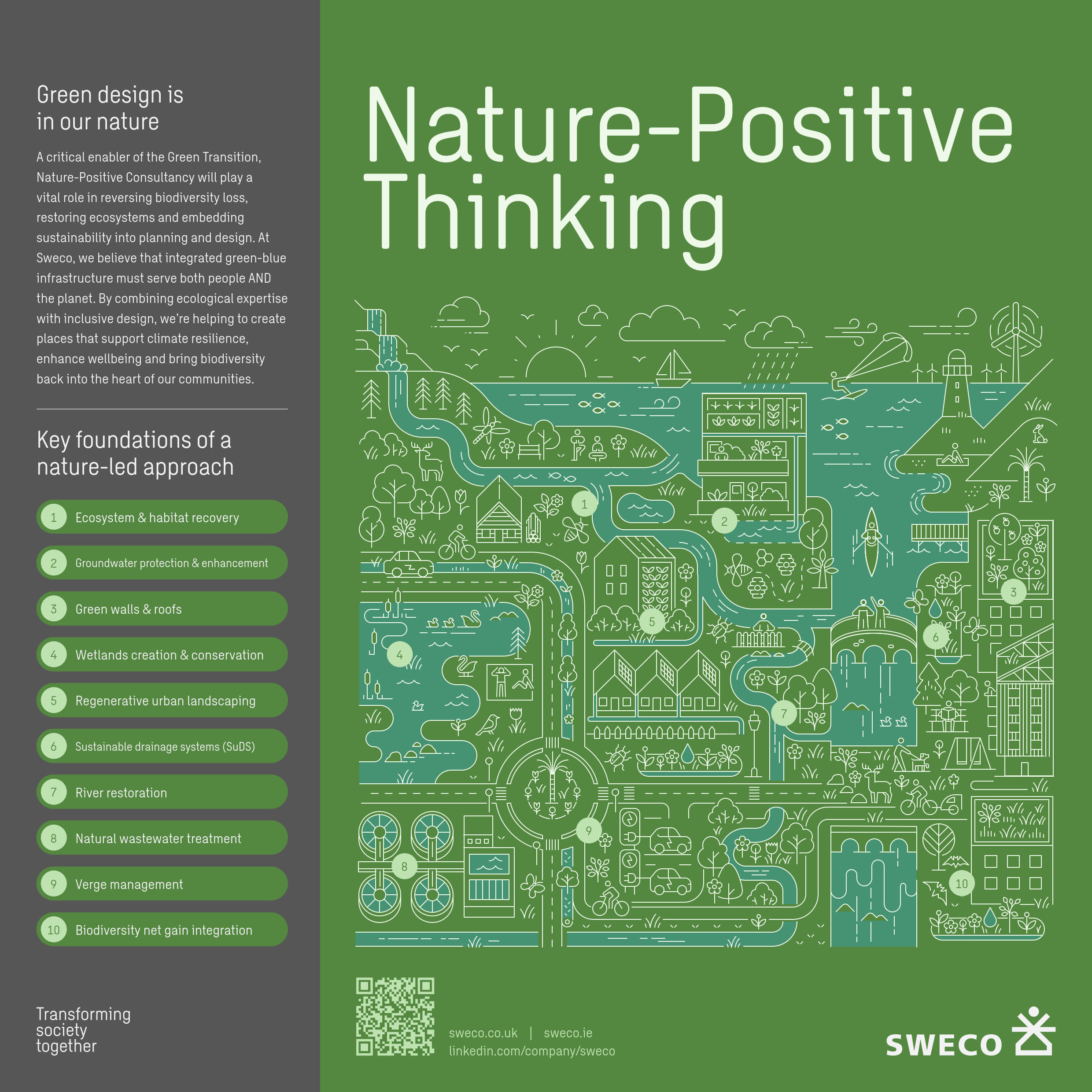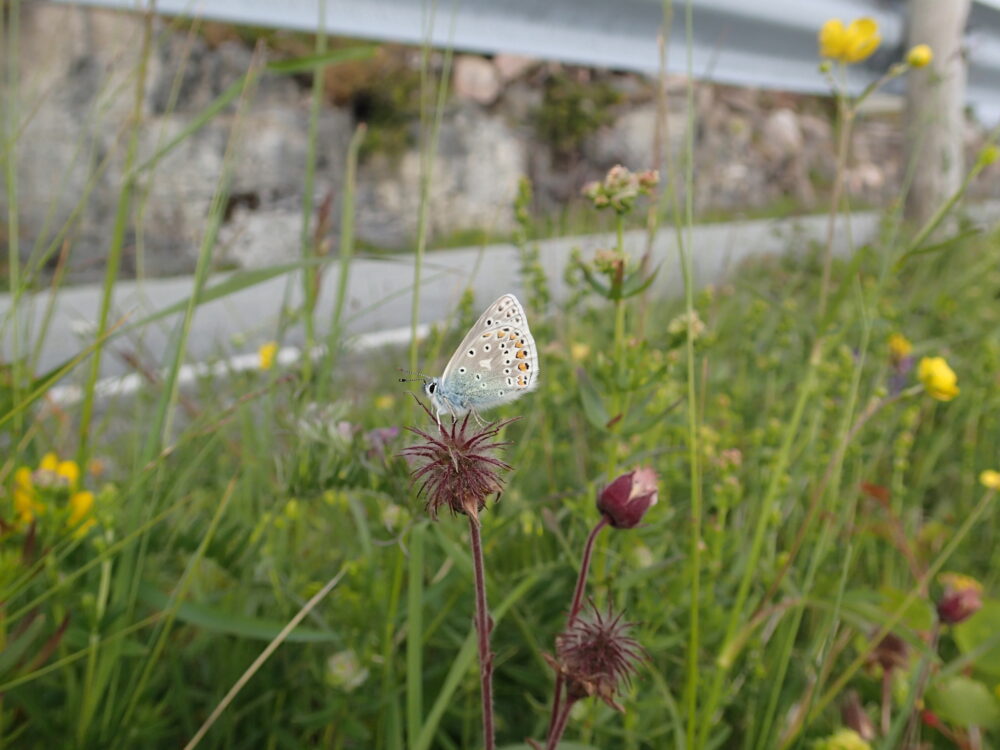Biodiversity Net Gain (BNG) Planning Consultancy
Sweco’s leading Biodiversity Net Gain (BNG) consultants deliver a seamless approach to BNG compliance – helping developers, planners and landowners across England unlock project value, minimise risk and achieve measurable environmental benefits.
Our services span the full spectrum of nature-positive planning and engineering from SuDS, green-blue infrastructure and regenerative landscape design to habitat recovery, rewilding, BNG advisory and ecosystem restoration. Whether creating resilient water systems, restoring natural landscapes or putting biodiversity at the heart of the public realm, we help you meet your regulatory, social and environmental goals with a joined-up approach to transforming both rural and built environments for the better.

What is Biodiversity Net Gain?
Biodiversity Net Gain (BNG) is a statutory requirement in England, introduced under the Environment Act 2021, that obligates most new developments to deliver a measurable improvement in biodiversity. Using the Statutory Biodiversity Metric, developers must secure at least a 10% net gain in biodiversity value compared to the site’s pre-development baseline and maintain that gain for a minimum of 30 years, secured via legally binding agreements.
BNG is more than a regulatory obligation – it is an opportunity to add long-term value to your development and the wider environment.
Key Implementation Dates
From 1 February 2024: BNG became mandatory for major developments, including:
- 10+ dwellings or sites ≥0.5 ha
- Non-residential floor space ≥1,000 m² or sites ≥1 ha
From 2 April 2024: BNG requirements extended to minor developments, covering most small residential and commercial schemes.
From March 2026: BNG will apply to Nationally Significant Infrastructure Projects (NSIPs).
Exemptions: Householder applications, certain small-scale development (e.g. impacts <25 m² of habitat or <5 m of hedgerow), some permitted development rights, and temporary works lasting under two years.
Remember: BNG applies based on the planning application submission date, not the decision date.
How Sweco’s BNG guidance can help
Our ecologists ensure BNG requirements are not only met but add value to your project and the wider environment. Our approach is robust, defensible, and fully aligned with statutory and industry standards.
1. Baseline Ecological Assessment
UK Habitat Classification (UKHab): All baseline surveys use UKHab, as required by the Statutory Biodiversity Metric.
Optimal Survey Timing: Habitat surveys are conducted March–September, though surveys outside this period can be undertaken with justification.
Metric Calculation: We use the Statutory Biodiversity Metric tool to calculate baseline and predicted post-development “biodiversity units.”
2. The Mitigation Hierarchy
Our process strictly follows the mitigation hierarchy:
Avoid: Design development to avoid impacts on priority and irreplaceable habitats.
Minimise: Where avoidance isn’t possible, we recommend practical measures to minimise losses and disturbance.
Restore: Restore degraded habitats where feasible as part of the project.
Compensate/Offset: If the full 10% net gain cannot be achieved on-site, developers may deliver off-site habitat creation or enhancement using their own land or acquire biodiversity units from habitat banks. As a last resort, statutory biodiversity credits may be purchased. Off-site units must be legally secured and registered on Natural England’s Biodiversity Gain Site Register, while statutory credits are documented via proof of purchase in the Biodiversity Gain Plan submitted to the local planning authority.
3. Habitat Creation, Enhancement and Design
On-site Solutions: We design practical, locally relevant habitat enhancements – woodlands, grasslands, wetlands, hedgerows – for lasting ecological value.
Off-site Measures: Where on-site gains are limited, we identify and secure suitable off-site habitat creation, ensuring it aligns with Local Nature Recovery Strategies, where possible.
4. Legal Securing and Documentation
30-Year Legal Commitment: All BNG gains are secured for a minimum of 30 years via Section 106 agreements or Conservation Covenants, ensuring long-term stewardship.
Biodiversity Gain Plan (BGP): Prepared after permission is granted but before commencement, including baseline data, metric calculations, habitat mapping, management prescriptions, and monitoring schedules.
5. Long-Term Management and Monitoring
Management Plans: We produce tailored management plans with clear objectives and measurable outcomes.
Monitoring: Statutory monitoring occurs every 5 years, with additional checkpoints (e.g. years 1, 5, 10, 20, 30) recommended for adaptive management if targets are not met.
Reporting: We handle all reporting to Local Planning Authorities and, where required, Natural England.
6. Stakeholder Engagement and Regulatory Liaison
Early Engagement: We initiate early conversations with regulators, planning authorities, and local stakeholders to streamline the process and maximise support.
Transparent Audit Trail: All our work is thoroughly documented, ensuring an accessible record for audits, planning, and future management.
Why early ecological input matters for BNG
BNG is both a statutory requirement and an opportunity to deliver genuine environmental value.
Engaging Sweco’s ecology team at the outset means BNG is embedded in every stage – from initial feasibility and site design, to planning, delivery, and long-term management. This minimises risk, reduces costs, and maximises opportunities for both compliance and environmental benefit. Our technical experts operate at the forefront of evolving policy, ensuring your project is always one step ahead.
Sweco’s ecology team will guide you through every stage – efficiently, reliably, and with integrity.
Contact us today for a BNG feasibility appraisal or to discuss your project’s specific needs.
Frequently Asked BNG Questions
Does BNG apply to my project?
If your development is in England and isn’t specifically exempt, BNG almost certainly applies. Our team can confirm your obligations.
How do I get started with BNG?
Early ecological assessment is key. Contact us for a no-obligation feasibility review.
What happens if I don’t comply?
Non-compliance risks planning refusal, regulatory enforcement, and reputational harm.
We don’t have to choose or compromise. It’s about embracing the ‘and’ – nature and climate change, and resilience, and clean air, and great spaces, and efficient critical infrastructure. It’s about doing right by people and the planet.
Bryn Jones, Nature-based Solutions Lead
A nature positive mindset
Nature positive thinking provides benefits for both people and the planet, and can also be more cost-effective than other alternative ‘non-natural’ alternatives. A core element of the green transition, focusing on nature not only reduce the impacts of climate change but actively enhances biodiversity – building resilience and enhancing adaptation to climate change by helping to safeguard human health, combat food and water scarcity and reduce the risk of disasters such as flood and extreme heat events.
With multi-disciplinary expertise across the planning, design, engineering and asset management lifecycle, we can guide you on the possibilities and opportunities of a nature-positive approach and also help implement and manage them with our global network of biodiversity and engineering specialists for long-term gains.

